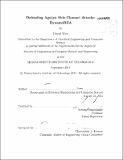| dc.contributor.advisor | Saman Amarasinghe and Eran Tromer. | en_US |
| dc.contributor.author | Wen, David, M. Eng. (David Y.). Massachusetts Institute of Technology | en_US |
| dc.contributor.other | Massachusetts Institute of Technology. Dept. of Electrical Engineering and Computer Science. | en_US |
| dc.date.accessioned | 2013-02-14T15:35:59Z | |
| dc.date.available | 2013-02-14T15:35:59Z | |
| dc.date.copyright | 2011 | en_US |
| dc.date.issued | 2011 | en_US |
| dc.identifier.uri | http://hdl.handle.net/1721.1/76992 | |
| dc.description | Thesis (M. Eng.)--Massachusetts Institute of Technology, Dept. of Electrical Engineering and Computer Science, 2011. | en_US |
| dc.description | Cataloged from PDF version of thesis. | en_US |
| dc.description | Includes bibliographical references (p. 67-68). | en_US |
| dc.description.abstract | Modern computer architectures are prone to leak information about their applications through side-channels caused by micro-architectural side-effects. Through these side-channels, attackers can launch timing attacks by observing how long an application takes to execute and using this timing information to exfiltrate secrets from the application. Timing attacks are dangerous because they break mechanisms that are thought to be secure, such as sandboxing or cryptography. Cloud systems are especially vulnerable, as virtual machines that are thought to be completely isolated on the cloud are at risk of leaking information through side-channels to other virtual machines. DynamoREA is a software solution to protect applications from leaking information through micro-architectural side-channels. DynamoREA uses dynamic binary rewriting to transform application binaries at runtime so that they appear to an observer to be executing on a machine that is absent of micro-architectural side-effects and thus do not leak information through micro-architectural side-channels. A set of test applications and standard applications was used to confirm that DynamoREA does indeed prevent sensitive information from leaking through timing channels. DynamoREA is a promising start to using dynamic binary rewriting as a tool to defend against side-channel attacks. | en_US |
| dc.description.statementofresponsibility | by David Wen. | en_US |
| dc.format.extent | 68 p. | en_US |
| dc.language.iso | eng | en_US |
| dc.publisher | Massachusetts Institute of Technology | en_US |
| dc.rights | M.I.T. theses are protected by
copyright. They may be viewed from this source for any purpose, but
reproduction or distribution in any format is prohibited without written
permission. See provided URL for inquiries about permission. | en_US |
| dc.rights.uri | http://dspace.mit.edu/handle/1721.1/7582 | en_US |
| dc.subject | Electrical Engineering and Computer Science. | en_US |
| dc.title | Defending against side-channel attacks : DynamoREA | en_US |
| dc.title.alternative | DynamoREA : defending against side-channel attacks | en_US |
| dc.type | Thesis | en_US |
| dc.description.degree | M.Eng. | en_US |
| dc.contributor.department | Massachusetts Institute of Technology. Department of Electrical Engineering and Computer Science | |
| dc.identifier.oclc | 825553946 | en_US |
